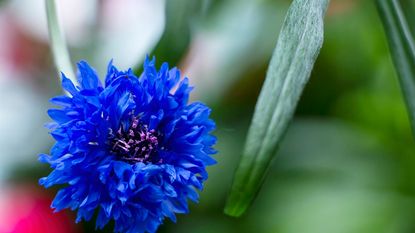Bachelor's Button Plant History


You just have to love bachelor's button flowers - one of the truest blues in Mother Nature's palette. Today, the flower is available in shades of purple, pink and white. Not surprisingly, the old-fashioned wildflower is known by a number of names, including cornflower, blue bottle, blue bonnet, basket flower, bluet or boutonniere flower. Bachelor's button is not only beautiful, but bachelor's button facts (and rumors) are fascinating. Read on for just a few bachelor's button tidbits.
History of Bachelor's Buttons
Why are these lovely, silvery-stemmed plants known as bachelor's button flowers? Plant historians say that during the Victorian era, men traditionally tucked a bloom into a jacket buttonhole to let single ladies know they were available and unencumbered. Rumor has it that bachelor's button was John F. Kennedy's favorite flower, and that on the day he married Jackie, he wore a bachelor's button boutonniere. Ah, Camelot! Bachelor's button flowers were reportedly found in the tomb of King Tut, who died in 1,340 B.C. Historians think that the flowers, woven into a wreath, were placed around the boy king's head to ease his way to the afterlife. Native to Asia and Europe, bachelor's button plants were introduced to North America by European settlers in the 1600s, and today, they are grown around the world. The flowers are beautiful in bouquets and they are easy to dry for dried flower arrangements. They are also edible, with a slightly spicy, clove-like flavor. They are often used as a colorful garnish, usually to liven up a green salad. Many people like to brew the dried flowers into tea.
Growing Bachelor's Button Plants
Bachelor's buttons are easy to grow by planting seeds after all danger of frost has passed in spring. It grows in nearly any type of well-drained soil. This hardy annual requires full sun and tolerates hot, dry weather, but performs best with moderate water.
Gardening tips, videos, info and more delivered right to your inbox!
Sign up for the Gardening Know How newsletter today and receive a free download of our most popular eBook "How to Grow Delicious Tomatoes."

A Credentialed Garden Writer, Mary H. Dyer was with Gardening Know How in the very beginning, publishing articles as early as 2007.
-
 How To Grow Garden To Table: A Guide For Home Cooks
How To Grow Garden To Table: A Guide For Home CooksWhat could be better than a meal that comes directly from garden to table? Show off your gardening and culinary skills with the very freshest food.
By Bonnie L. Grant
-
 Want a Backyard Mini Orchard? Create Your Own Container Orchard
Want a Backyard Mini Orchard? Create Your Own Container OrchardEasier to care for in small spaces, a backyard mini-orchard makes sense for busy gardeners and juicy fruit is the reward.
By Teo Spengler